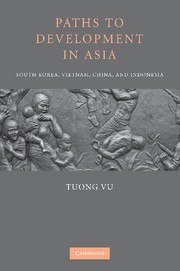Book contents
- Frontmatter
- Contents
- List of Tables and Figure
- Acknowledgments
- List of Abbreviations
- 1 State Formation Dynamics and Developmental Outcomes
- PART ONE DIVERGENT NATIONAL PATHS OF STATE DEVELOPMENT
- 2 South Korea: Confrontation and the Formation of a Cohesive State
- 3 Indonesia: From Accommodation to Confrontation
- 4 Rival State Formations in China: The Republican and Maoist States
- 5 Vietnam: Accommodation and Arrested Revolution
- PART TWO VARIANTS OF ACCOMMODATION: VIETNAM AND INDONESIA COMPARED
- References
- Index
2 - South Korea: Confrontation and the Formation of a Cohesive State
Published online by Cambridge University Press: 04 August 2010
- Frontmatter
- Contents
- List of Tables and Figure
- Acknowledgments
- List of Abbreviations
- 1 State Formation Dynamics and Developmental Outcomes
- PART ONE DIVERGENT NATIONAL PATHS OF STATE DEVELOPMENT
- 2 South Korea: Confrontation and the Formation of a Cohesive State
- 3 Indonesia: From Accommodation to Confrontation
- 4 Rival State Formations in China: The Republican and Maoist States
- 5 Vietnam: Accommodation and Arrested Revolution
- PART TWO VARIANTS OF ACCOMMODATION: VIETNAM AND INDONESIA COMPARED
- References
- Index
Summary
TRAUMATIC EVENTS AND A THEORETICAL LACUNA
On August 19, 2004, the leader of South Korea's ruling party, Shin Ki-nam, tearfully announced his resignation after his father's work decades before as a member of the military police force serving the Japanese colonial government became known. “I still find it shocking and difficult to believe the details of recent reports about my father,” he said. Shin was the first victim of an inquiry launched by President Roh Moo-hyun into South Korea's modern history, including the Japanese occupation from 1910 to 1945 and authoritarian rule until 1987. Just two years before, when President Roh himself was running for election, the news came out that his father-in-law had been a left-wing activist, was arrested during the Korean War, and died in prison when Roh's wife was a child. When a rival took issue with Roh's father-in-law's record during the heated presidential race, Roh shot back, “Should I leave my wife just because of her father, who I never even met?”
When these two recent episodes in Korean politics are placed next to each other, a great irony emerges. The two men now belong to the same ruling party, but one's father and the other's father-in-law used to be enemies. And the man who was not mentioned in the newspaper stories but who loomed large behind both was President Rhee Syngman (1948–60). Under his rule, Mr. Shin's father was protected and promoted, while Mrs. Roh's father languished in jail and died a premature death.
- Type
- Chapter
- Information
- Paths to Development in AsiaSouth Korea, Vietnam, China, and Indonesia, pp. 27 - 49Publisher: Cambridge University PressPrint publication year: 2010
- 1
- Cited by



